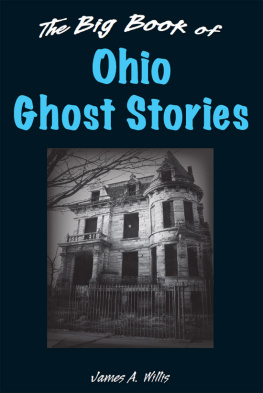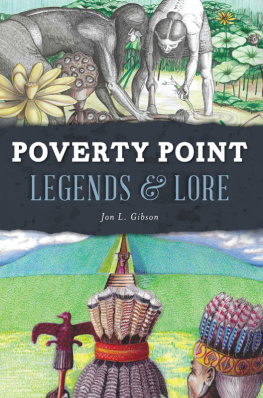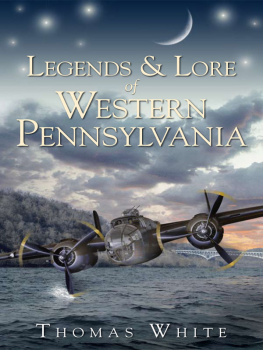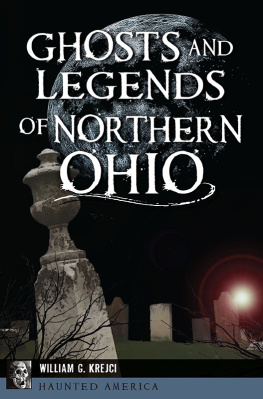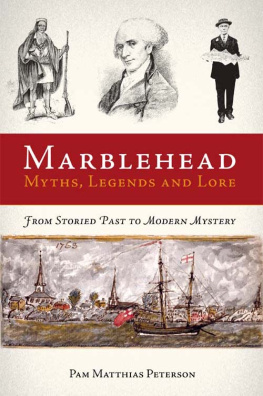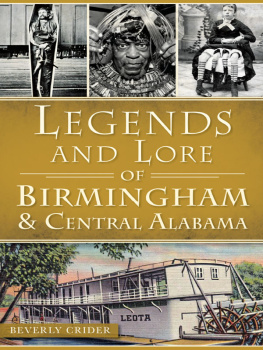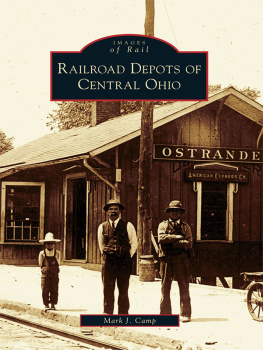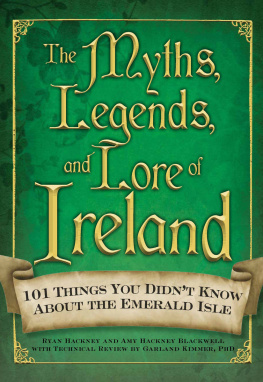


Published by The History Press
Charleston, SC
www.historypress.net
Copyright 2017 by James A. Willis
All rights reserved
Front cover, top left: author photo; top center: author photo; top right: author photo; bottom: Little City of Black Diamonds/New Straitsville History Group.
First published 2017
e-book edition 2017
ISBN 978.1.43966.083.6
Library of Congress Control Number: 2017931821
print edition ISBN 978.1.46713.668.6
Notice: The information in this book is true and complete to the best of our knowledge. It is offered without guarantee on the part of the author or The History Press. The author and The History Press disclaim all liability in connection with the use of this book.
This book is intended as entertainment and as a historical record of Ohio ghost stories, legends and folklore. Many of these stories cannot be independently confirmed or corroborated, and the author and publisher make no representation as to their factual accuracy. Readers should be advised that some of the sites described in this book are located on private property and should not be visited, or they may face prosecution for trespassing.
All rights reserved. No part of this book may be reproduced or transmitted in any form whatsoever without prior written permission from the publisher except in the case of brief quotations embodied in critical articles and reviews.
Steve and Carol FleeFor love, support and for continuing to trust
such a strange and spooky guy with their daughter.
CONTENTS
ACKNOWLEDGEMENTS
Taking a closer look at how history and folklore can live side-by-side is often a daunting task. This book would not have been possible without the help and support of so many people, including Shirley and the staff of the J.E. Reeves Victorian Home and Carriage House Museum, the Dover Historical Society, Valda Lewis, Little Cities of Black Diamonds/New Straitsville History Group, Cheryl Blosser, Todd James Dean for unearthing the Stuart Pierson pic, Anne Touvell, Thurber House, Amanda Irle at The History Press, Heather OKronley, Dick Hoffman for the Camp Chase pics, Mark Moran and Mark Sceurman for being the first ones to allow me to explore my weird side and my paranormal peeps at the Ghosts of Ohio.
And last, but certainly not least, none of this would be possible without the love and support from Stephanie and Courtney, both of whom can still melt me with a single smile.
INTRODUCTION
According to legend
Oh, how I love to hear those words! It lets me know Im getting ready to hear a mix of fact and fiction, rolled up into one amazing tale. But just what is real and what was created specifically to add a little spice to the story? That, gentle readers, is the question that has kept me going for over thirty years.
Most of you know me as Weird Willis or the Ghost Guymonikers I accept and wear with pride. But at the core of what I do is an insatiable appetite to get to the truth behind the legends.
That obsession started at an early age. During a class trip to Tarrytown, New York, home of the infamous Headless Horseman of Sleepy Hollow, someone tried to convince me the headless guy really did exist and that his story was true. As evidence, they pointed to various locations mentioned in the book and even the tombstones of some of the characters.
Years later, when I came to the realization that Washington Irving simply borrowed the names and places in Tarrytown for The Legend of Sleepy Hollow, I asked myself, OK, that legend isnt true, but are there any that are? Decades later, Im living in Ohioand still asking myself that question.
One of the things Ive come to love about Ohio and Ohioans in general is that theyre weird and proud of it. Buckeye legends and folklore tend to be a bit out there, too. Whats more, Ohioans seem to take a bit of fiendish glee in wrapping real-life people and locations together in a cloud of mystery, along with, to be honest, some bizarre stuff made up for no other reason than to make the tale a bit more interesting.
What you are often left with is something that is known to make more than a few traditional historians cringe. Ghosts? Monsters? Unidentified flying objects? Those things are not history.
Oh, but they are!
Ask anyone, and they will tell you that at some point in their life they went looking for a ghost, thought they saw a UFO or merely wondered if the legend they heard about a place was true. Guess what? Those people, even without knowing it, were immersing themselves in history. Thats because if you peel back the outer layer of legends and lore, you will find nuggets of real, verifiable and, in some cases, tangible history. They are all there. You just have to dig to find them.
Now, how did I divide up Ohios legends and lore in order to determine which ones were considered Central? Simple. I drew two equidistant horizontal lines through the state. Anything above the first line was considered Northern Ohio, and anything below the second line became Southern Ohio. That sweet spot between the two lines? Central Ohio.
But what of the other two areas, Northern and Southern Ohio? Time will tell, but for now, lets say I have plenty of tales to fill both of those books, too.
OK, enough yakking, lets dig in. I hope you enjoy pursuing all the strange and spooky tales included within these pages. I certainly enjoyed collecting them for your review. For they are the stuff legends are made of.
PART I
FAMOUS GHOST
STORIES
CAMP CHASE CONFEDERATE
CEMETERY
There is a long-standing legend surrounding Columbuss Camp Chase Confederate Cemetery. Folks say the place is haunted. At first glance, the idea of a cemetery being haunted is nothing new: graveyards around the world are said to be haunted. What makes the ghost stories associated with Camp Chase unique? For starters, while many people have seen the ghost of a woman here, no one knows who she is. But the most intriguing aspect of the legend is the historical facts regarding how so many Confederate soldiers came to be buried in Ohio.
With the outbreak of the Civil War in April 1861, President Lincoln put out the call for men in Union states to rally and enlist in the army to help defeat the Confederates. Ohioans who enlisted were originally sent to train at Columbuss Camp Jackson. But the number of Ohio men willing to take up arms was so great that Camp Jackson was quickly overcrowded. The following month, construction quickly began on another training facility near Camp Jackson. Within weeks, 160 houses for the trainees were built. Camp Chase officially opened on June 20, 1861. The facility was named after former Ohio governor Salmon P. Chase, who was also President Lincolns treasury secretary.
In addition to the houses and facilities for the Union men, a small area in the southeast corner of the camp was set aside for use as a prison facility. The stockade and buildings inside were designed to hold approximately 450 prisoners. Historians believe the creation of this stockade was a bit of an afterthought and that the primary function of the facility was to train men entering the Union army. That would soon change.






